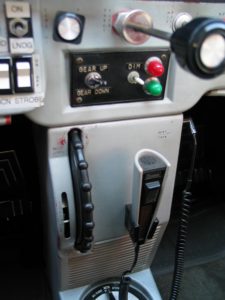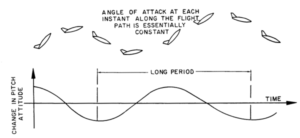
An airplane flying in trim is a truly beautiful thing. It exemplifies balance in all its forms.
An airplane trimmed for straight and level flight will maintain that straight and level flight. It has settled into the perfect balance between lift, thrust, weight, and drag. The forces are in equilibrium. It’s steady.
Sure, things happen. Maybe the pilot bumps into the control yoke and the nose drops. Sure, the plane will start to dive, but then an interesting phenomenon called phugoid oscillation takes place. As the nose drops, the airplane picks up speed. That additional speed adds lift, and the nose rises again. Generally, inertia in the airframe causes the nose to overshoot, rising a little too high. Airspeed drops, lift decreases, and the nose drops again. The cycle repeats.

You’d think it would keep going indefinitely, but it doesn’t. Moving the nose up and down requires angular acceleration of the airframe’s mass. Actual work is done by that acceleration, and that work represents a loss in the system, so the oscillations get smaller and smaller until they eventually damp out completely, leaving you in level flight once again.
Sometimes, an inexperienced pilot will see a phugoid cycle happening and overcorrect for it. When the nose goes down he’ll pull up, screwing up the natural damping of the cycle. And when the nose rises he’ll try to push it back over a bit too hard, forgetting that it’ll fix itself if he is just gentle with it … or in fact, just leaves it alone. This has been termed “Pilot-Induced Oscillation,” usually caused by the pilot trying to follow an indication that lags behind the actual state of the airplane. (Following the vertical speed indicator, which has a natural lag of a few seconds, is a typical student pilot mistake.)
This all came to mind this morning because I seem to be trying to trim my own life, and I’m having a hard time. I understand the physics of flight really, really well, but even after 55 years of trying, I haven’t learned a thing about how my life works. So I keep having these oscillations, and I think I’m probably inducing them myself.
When something bad happens, I ham-handedly overcorrect. That pushes things rapidly the other way, because I’m reacting to my own reactions. It’s so, so easy to get into divergent modes and then horse the controls around, putting myself in an even more divergent mode, sometimes on all axes. Pilots call this a “departure” or “upset,” but to me they’re more like crashes. My life should be used to train NTSB investigators. Find the cause. Pilot error.Â
Talking my hands off the controls is hard. It’s my natural instinct to try to fix things, to correct the divergence, to get back into trim. It’s not a perfect metaphor but it’s working for me right now. It describes what’s happening. And I don’t feel I’ve really been properly trimmed for a long time.Â
This is one of those places where the old “first, fly the airplane” advice from my first flight instructor begins to lose its wisdom. Flying the airplane is the very problem I’m fighting with.
And at the moment I’m flying a life that’s got badly mis-rigged control cables, wobbling gyros, bees nesting in the pitot tube, one bad magneto, no stall warning, and a busted radio.
Even on a calm day this thing’s a bitch to fly.
Permalink
You forgot the story bout the beanfield, a wingtip, and a ballcap.
call us
619-672-1333